Metrics Overview
UpdatedMetrics throughout Customer.io show you how well your messaging strategies are working or if there’s anything unexpected happening. We provide a variety of views so you can learn about everything from workspace-wide performance to Campaign journeys.
What does Customer.io measure?
We primarily focus on two kinds of metrics. You may find a combination of both of these things on the Dashboard, Analysis, and Campaign Overview pages. While they often correspond, it’s important to note that we measure two different things.
- Campaign journeyTypically, a person’s path through your campaign. If the campaign is triggered by a webhook, then a journey captures the webhook’s path, not a person’s. metrics, which help you learn about how people progress through campaigns.
- Message/deliveryThe instance of a message sent to a person. When you set up a message, you determine an audience for your message. Each individual “send”—the version of a message sent to a single member of your audience—is a delivery. metrics, which help you determine how well your messages perform.
On your Dashboard, we also calculate:
- Segment membership metrics, which show how membership in segments changes over time.
- Test metrics, showing how your A/B tests have performed and which entry in the test won.
- Link metrics, which help you understand which of your links your audience clicks most often.
How we calculate campaign journey and message metrics
A journey is the instance of a campaign that a person experiences. A message is an individual message in the campaign. So, a person who receives a message might be in progress in their campaign journey, but have opened or clicked a message in that campaign. Their interaction with the message is done, but they’re still working their way through the journey.
Metrics do not report actions on the date they occur. Instead, metrics are reported against the date a journeyTypically, a person’s path through your campaign. If the campaign is triggered by a webhook, then a journey captures the webhook’s path, not a person’s. or a messageThe instance of a message sent to a person. When you set up a message, you determine an audience for your message. Each individual “send”—the version of a message sent to a single member of your audience—is a delivery. is created.
It may be helpful to think of metrics as an answer to the question: of messages and/or journeysTypically, a person’s path through your campaign. If the campaign is triggered by a webhook, then a journey captures the webhook’s path, not a person’s. created on a particular date, how many achieved a particular status?. This also means that corresponding metrics for journeys and messages may report on different dates because journeys can take a while and messages are more immediate.
For example, imagine that you have a campaign that sends messages over a five day period. A person enters the campaign on January 1st; they open and convert based on the last message—sent and received on January 6th. The converted metric for this journey is reported on the 1st—because the journey, created on the 1st, has converted. The converted metric for the message is reported on January 6th, because the message was created on the 6th.
Dashboard metrics are measured in Eastern time (Etc/GMT+4).
This means metrics aggregate based on EST, not your system’s time zone. For example, say a message was sent at 03:59:59 UTC. That message metric would be tracked against the previous day’s metrics totals, since it’s before 00:00:00 Etc/GMT+4 (04:00:00 UTC). Learn more about dates and time in Customer.io.
Message Performance and Delivery Metrics
Customer.io generates the following metrics to determine the performance of your messages. By default, we calculate metrics based on the number of deliveriesThe instance of a message sent to a person. When you set up a message, you determine an audience for your message. Each individual “send”—the version of a message sent to a single member of your audience—is a delivery. that successfully make it to recipients, though you can change this setting if you don’t send messages using our default sending domain and you don’t send delivery metrics to Customer.io from your delivery provider.
Your message was successfully sent from Customer.io to the delivery provider. It is their responsibility to ensure the message is properly delivered, and we’re waiting for further information to determine if the user interacted with it. Delivered means that we’ve received confirmation from the delivery provider that a message was delivered to the recipient’s email service provider (ESP). For email, we count an open when the recipient’s email client loads an invisible image (tracking pixel) or when the recipient clicks one of the links in the email. If a customer has images disabled in their email client and an open is tracked based on a click event, the “Opened Email” and the “Clicked Email” events will show as having occurred at the same time. Email open metrics can be misleadingly high or low due to email client behavior. Use email opened metrics to track trends over time and investigate potential inbox placement issues. For in-app-messages, the opened metric means the message has been delivered and displayed to a person. For push notifications, our SDKs automatically track when they’re opened. If you don’t use our SDKs, you need to send us events to track push notification opens.Sent
Delivered
Opened
Human opened
This metric is available for emails opened since March 20, 2025. Compared to the opened metric, the human opened metric excludes emails opened by Apple’s Mail Privacy Protection, Gmail’s prefetching of images, user agents identified as bots, and known scanners—based on the MX hosts from the recipients’ email domains, within a few seconds of delivery.
Machine opened
This metric is available for emails opened since March 20, 2025. This metric includes opens by Apple’s Mail Privacy Protection, Gmail’s prefetching of images, and user agents identified as bots. It also captures opens identified as known scanners, based on the MX hosts from the recipients’ email domains, within a few seconds of delivery. In the UI, this metric is calculated as the difference between Opened and Human Opened to ensure Opened reflects the total.
Clicked
The user clicked on any link in a message where link tracking was enabled. We also track clicks on individual links.
Human clicked
This metric is available for tracked links in emails since April 20, 2025. Compared to the clicked metric, the human clicked metric excludes clicks from automated security scanners, bot user agents, known proxy services, and repetitive click patterns identified by our proprietary algorithm as non-human interactions.
Machine clicked
This metric is available for tracked links in emails since April 20, 2025. This metric includes clicks from automated security scanners, bot user agents, known proxy services, and repetitive click patterns identified by our proprietary algorithm as non-human interactions. In the UI, this metric is calculated as the difference between Clicked and Human Clicked to ensure Clicked reflects the total.
Click-to-open
This measures the rate at which people click tracked links in messages that they open, and is calculated by dividing Clicked metrics by Opened metrics.
A delivered message is marked as converted when a person achieves your campaign’s goal within the conversion criteria window. The message must have been sent, opened, or had a tracked link clicked within a specified time period. Learn more about goals and conversion timing. A message is counted as unsubscribed when a user unsubscribes from all messages. You can read more about how global unsubscribes work in Customer.io. Unsubscribed from topics counts each subscription topic that a user unsubscribed from through a delivered message. As such, you may see a percentage above 100; say you have 4 subscription topics and 5 messages are delivered to five users. Two users unsubscribe from 3 topics each (6 total). We would divide this by the number of delivered messages (5) to get 1.2 or 120% unsubscribed from topics. You can read more about how our subscription center works in Customer.io. For emails, this means that the end-user marked the email as ‘Spam’ via their email service provider. All subsequent emails are then marked “suppressed.” A failed message never made it to the delivery provider. We have a separate article to help you diagnose why your message never left Customer.io. For email, this means the user’s email address wasn’t valid. This could be a hard bounce (usually a permanent issue like a non-existent email address) or a soft bounce (a temporary issue like a full mail box). In the case of hard bounces for emails, subsequent messages to those addresses will be given the “suppressed” status. A message is marked as suppressed if:Converted
Unsubscribed
Unsubscribed from topics
Marked-as-spam
Failed
Bounced
Suppressed
We don’t record metrics for messages that are more than 6 months old.
If someone opens your message more than 6 months after you sent it, we won’t attribute an open to your message. We ignore metrics for older messages to keep your workspace running quickly.
Set the denominator for message metrics
By default, we calculate message metrics based on the number of messages delivered. This helps you gauge message performance based on the number of messages that actually reach your audience’s inboxes.
However, you should change your metrics to calculate based on the number of messages sent if:
- You don’t use our default sending domain
- You don’t send Delivery metrics to Customer.io from your delivery provider.
To change the denominator (Delivered or Sent) for your metrics:
- Go to Settings > Workspace Settings > Email and click Settings.
- Go to the Custom SMTP tab and click Delivered or Sent to determine how your metrics are calculated.
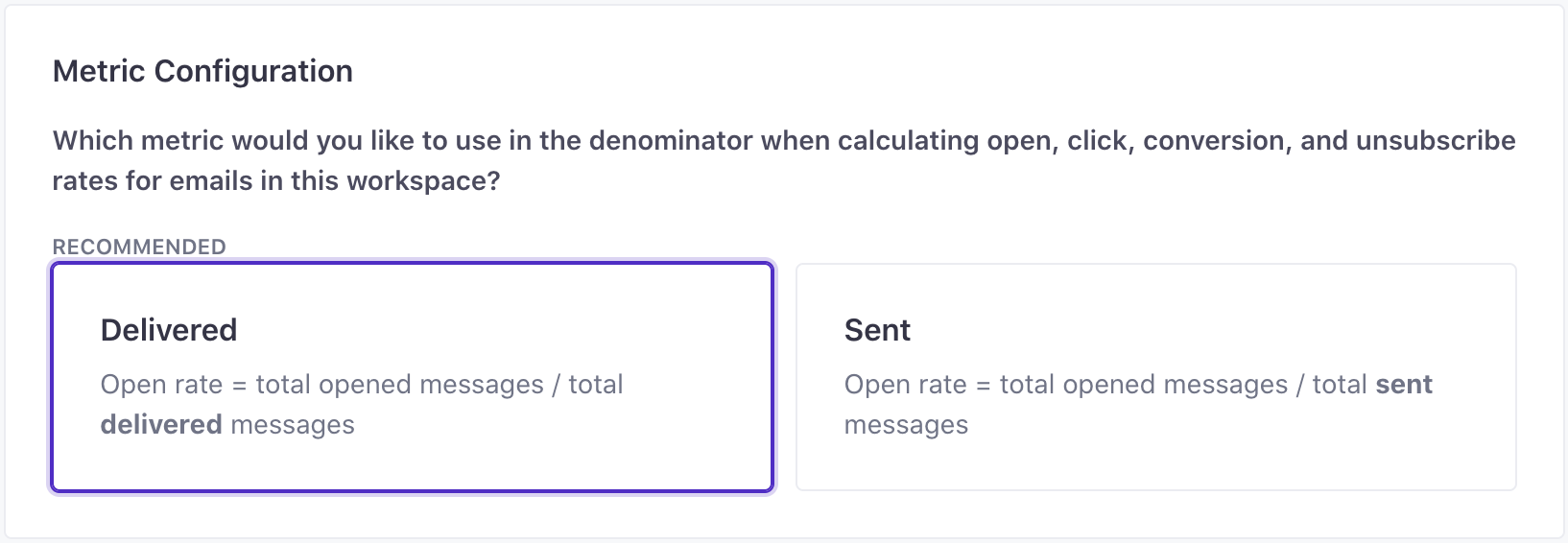

What we track for each message type
Different types of messages produce different metrics. If we can’t track a metric for a channel, you’ll either see a ‘-’ or 0.0% in its place, depending on the location in Customer.io.
| Delivered | Opened | Clicked | Converted | Bounced | Suppressed | Spammed | Unsubscribed | Unsubscribed from topics | |
|---|---|---|---|---|---|---|---|---|---|
| check_circle | check_circle | check_circle | check_circle | check_circle | check_circle | check_circle | check_circle | check_circle | |
| SMS | check_circle | highlight_off | check_circle | check_circle | check_circle | check_circle | highlight_off | highlight_off | highlight_off |
| Customer.io Push | check_circle1 | check_circle1, 2 | highlight_off | check_circle | check_circle | highlight_off3 | highlight_off | highlight_off | highlight_off |
| In-App | highlight_off | check_circle | check_circle | check_circle | highlight_off | highlight_off | highlight_off | highlight_off | highlight_off |
| Slack Message | highlight_off | highlight_off | check_circle | highlight_off | highlight_off | highlight_off | highlight_off | highlight_off | highlight_off |
| Webhook | highlight_off | highlight_off | check_circle | check_circle4 | highlight_off | highlight_off | highlight_off | highlight_off | highlight_off |
How we track human opens and clicks
In your workspace, you’ll see Human and Machine metrics for Opens and Clicks. This only applies for emails.
While Opened and Clicked metrics aggregate human and machine metrics, Human Opened and Human Clicked metrics only track interactions attributed to people. And Machine Opened and Machine Clicked only track interactions with bots and automated systems.
- Human opened: This metric is available for emails opened since March 20, 2025. Compared to the
openedmetric, thehuman openedmetric excludes emails opened by Apple’s Mail Privacy Protection, Gmail’s prefetching of images, user agents identified as bots, and known scanners—based on the MX hosts from the recipients’ email domains, within a few seconds of delivery. - Machine opened: This metric is available for emails opened since March 20, 2025. This metric includes opens by Apple’s Mail Privacy Protection, Gmail’s prefetching of images, and user agents identified as bots. It also captures opens identified as known scanners, based on the MX hosts from the recipients’ email domains, within a few seconds of delivery. In the UI, this metric is calculated as the difference between Opened and Human Opened to ensure Opened reflects the total.
- Human clicked: This metric is available for tracked links in emails since April 20, 2025. Compared to the
clickedmetric, thehuman clickedmetric excludes clicks from automated security scanners, bot user agents, known proxy services, and repetitive click patterns identified by our proprietary algorithm as non-human interactions. - Machine clicked: This metric is available for tracked links in emails since April 20, 2025. This metric includes clicks from automated security scanners, bot user agents, known proxy services, and repetitive click patterns identified by our proprietary algorithm as non-human interactions. In the UI, this metric is calculated as the difference between Clicked and Human Clicked to ensure Clicked reflects the total.
Human metrics are designed to help you understand how your audience is really engaging with your messages. As email clients, privacy tools, and security systems increasingly auto-open messages or register clicks, traditional open and click rates have become less reliable. Human metrics give you a clearer view of interactions that are most likely to reflect real people, not automated systems. Check out our blog to learn how to incorporate human metrics into your email marketing strategy.
Consider the following when interpreting these metrics:
- Apple’s Mail Privacy Protection hides IP addresses and preloads images to obfuscate open tracking, so all opens from Apple Mail are counted as non-human. However, we can identify human opens if someone clicks a link in the email. This makes the Human opened metric more accurate, but it will still be undercounted since we can’t detect human opens without a click.
- We calculate machine metrics in the UI differently from machine metrics in data-out integrations.
- Opened and Clicked metrics include both human and machine activity, but we don’t double count. That is, if a single email was opened by both a machine and a human, that counts as one in the aggregate metric. See examples below.
Viewing metrics in the UI
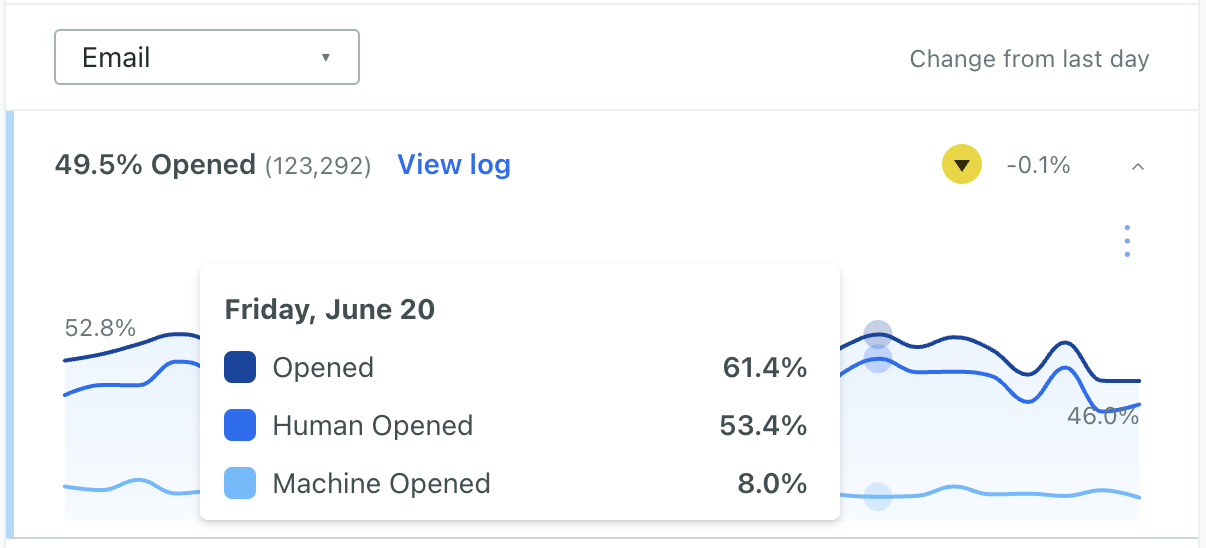

When you hover over graphs related to email, you’ll see all three of our Opened and Clicked metrics—the aggregate metric, human-specific metric, and machine-specific metric.
- Machine Opened is the difference between Opened and Human Opened metrics.
- Similarly, the Machine Clicked metric is the difference between Clicked and Human Clicked.
This ensures aggregate metrics always add up to 100% of human and machine metrics in the UI.
Retrieving metrics from data-out integrations
You can also retrieve human and machine metrics from our APIs, reporting webhooks, and data-out integrations.
The sum of machine and human metrics may not equal the sum of aggregate metrics because of how we log this data. For instance, if you were to retrieve an email’s metrics from our App API, human_opened plus prefetch_opened may not equal opened.
The following examples help explain how we count opens and clicks across machines and humans.
- Scenarios 1 and 2 demonstrate how we track opens when both a bot and human opened an email.
- Scenario 3 demonstrates that if a machine opens an email then a human clicks on it, we update the human opened and human clicked metrics and no longer attribute an open to a machine.
Scenario 1: Machine opens first, human opens second
- A machine first opens Email A:
prefetch_opened= 1human_opened= 0opened= 1
- A human subsequently opens Email A:
prefetch_opened= 1human_opened= 1opened= 1
Scenario 2: Human opens first, machine opens second
- A human first opens Email B:
prefetch_opened= 0human_opened= 1opened= 1
- A machine subsequently opens Email B:
prefetch_opened= 1human_opened= 1opened= 1
Scenario 3: Machine open, human click
- A machine first opens Email C:
prefetch_opened= 1human_opened= 0opened= 1
- A human subsequently clicks Email C:
prefetch_opened= 0human_opened= 1opened= 1
Journey Metrics
A journey is the instance of a campaign workflow that an individual person experiences.
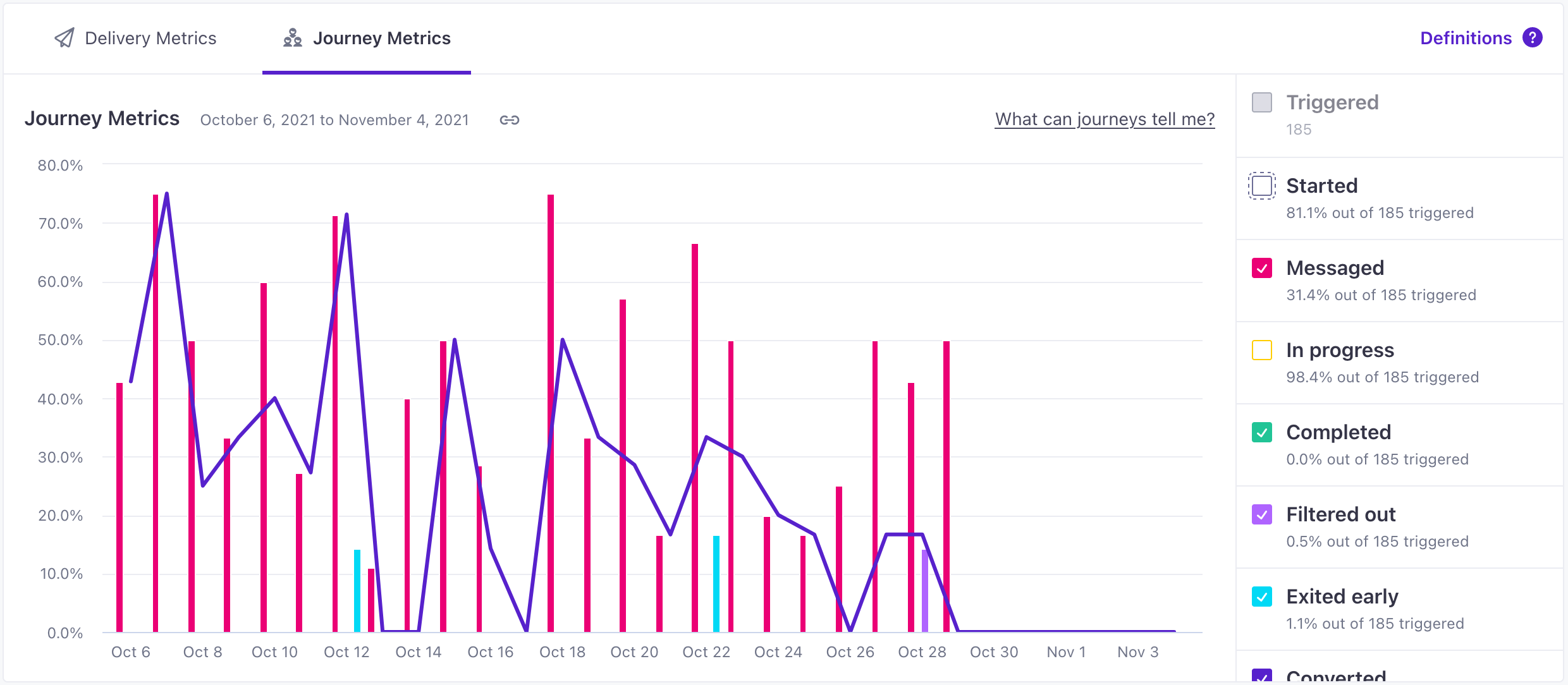

Journey metrics are calculated based on the total number of people who triggered your campaign within the selected time frame. However, a campaign trigger doesn’t necessarily represent someone who experienced your campaign. People can trigger a campaign, but be filtered out before they start the campaign (Started) or receive a message (Messaged).
People who matched the campaign trigger. People who trigger your campaign can be filtered out before they start it, representing a discrepancy between this metric and Started. You may want to compare this metric to Started to determine if the scope of your campaign is too wide or your filter is too narrow. You can only see this metric when you use the raw Count. In the Journey Metrics export, this metric is People who matched the campaign trigger, filter(s) and completed a non-delay action. Because you can potentially filter out people after they meet your campaign trigger, the Started metric effectively represents the total number of people eligible to experience your campaign. In the Journey Metrics export, this metric is People who experienced a message action in your campaign—an email, SMS, push notification, webhook, or Slack message. This includes drafted messages. People who have Triggered your workflow, and are waiting in a delay in your workflow, but have not yet exited, converted, or been filtered out. People who completed your campaign workflow by making their way to an exit action. People who matched your campaign trigger, but did not experience a journey/workflow. These are people who exited the campaign before experiencing a Started or Messaged state due to your campaign filters or other criteria during a delay action at the start of your campaign. In the Journey Metrics export, this metric is People who exited a campaign before completing an exit action. This may happen if a person stops matching the trigger and filter conditions while in a delay, their profile is deleted, or you manually remove them from a campaign. People who matched the conversion criteria for the campaign. People are “converted” when they enter or exit a designated segment in response to, or within a set time of, a delivery. If your campaign does not have conversion criteria, this metric is empty.Triggered
started.Started
activated.Messaged
In Progress
Completed
Filtered Out
never_activated.Exited Early
Converted
Links, Segments, and Tests
Your workspace Dashboard also shows information about your segments, links, and tests.
Links
The Links card shows the total link clicks for every link in the workspace. This allows you to view click metrics for links over any time range, and across any channel.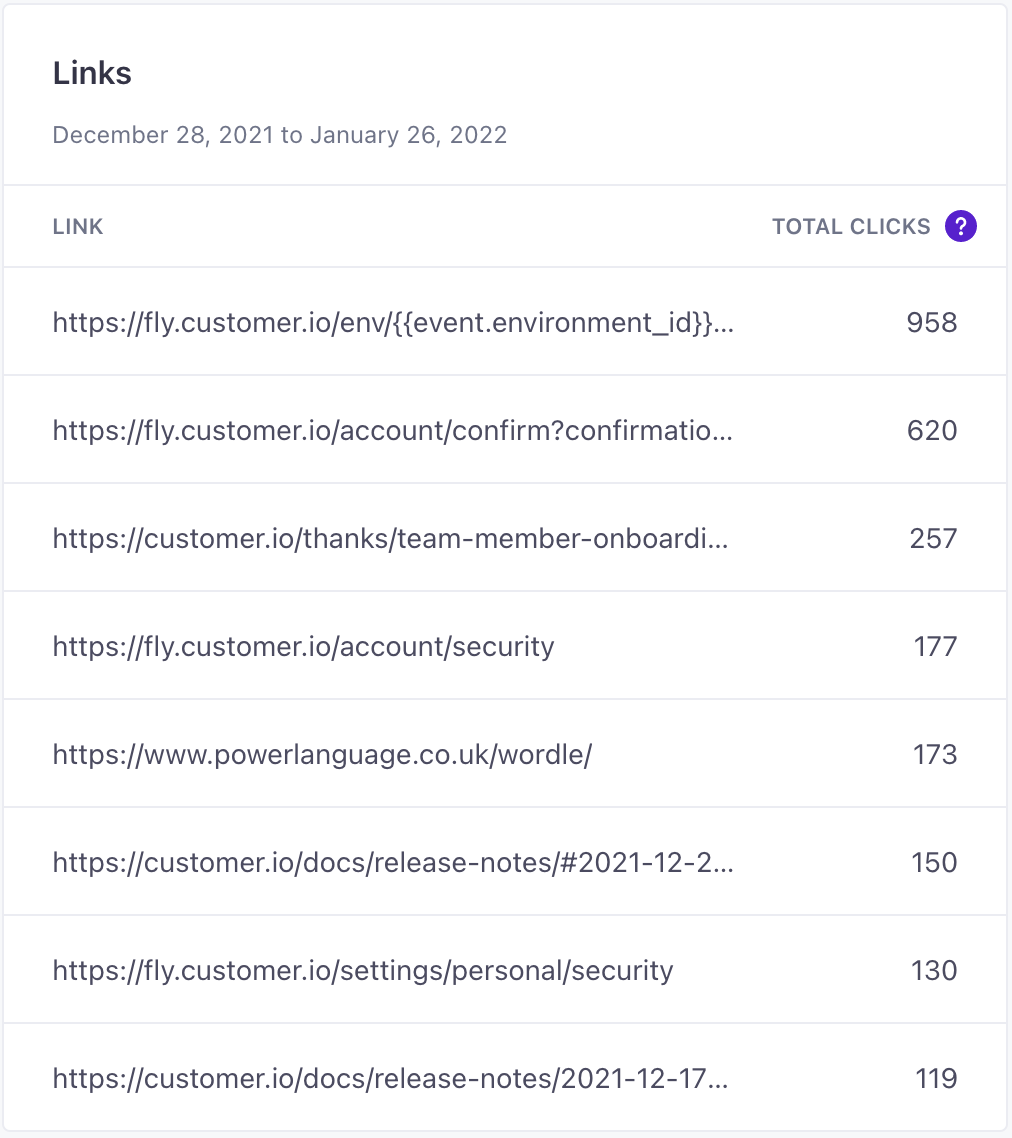

Segments
The Segments card allows you to see how membership counts for specific Segments have changed over time. You can choose any Segment you’d like from the drop down and your selection will be saved the next time you view the page. Pin the two Segments you care most about and keep an eye on them every time you login.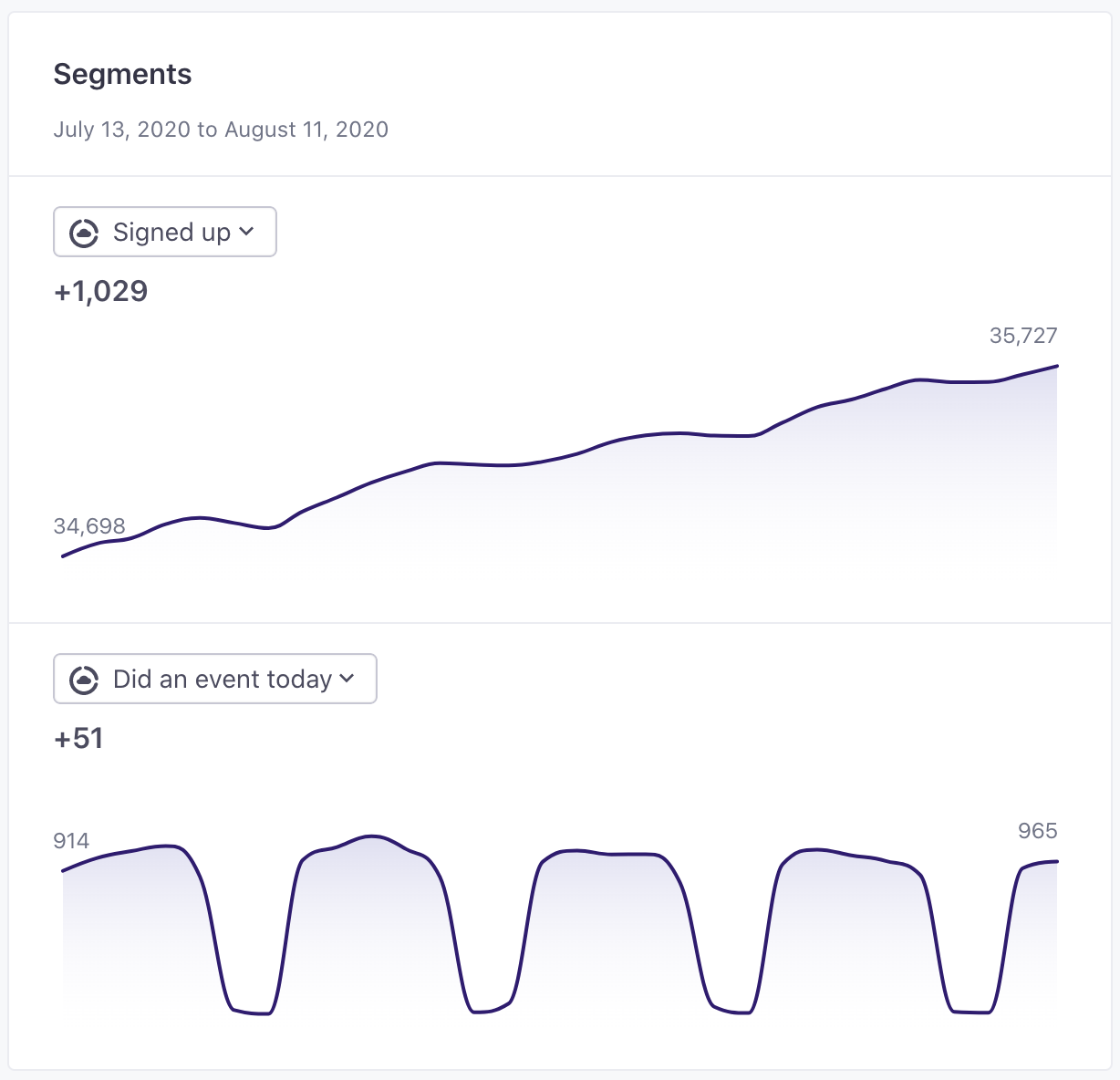

Tests
The Tests card shows all running tests in the workspace at the current time. This helps highlight tests that have been running longer than necessary, or that might be ready for completing based on their stats. Dive directly into the details of the test by clicking it in the list.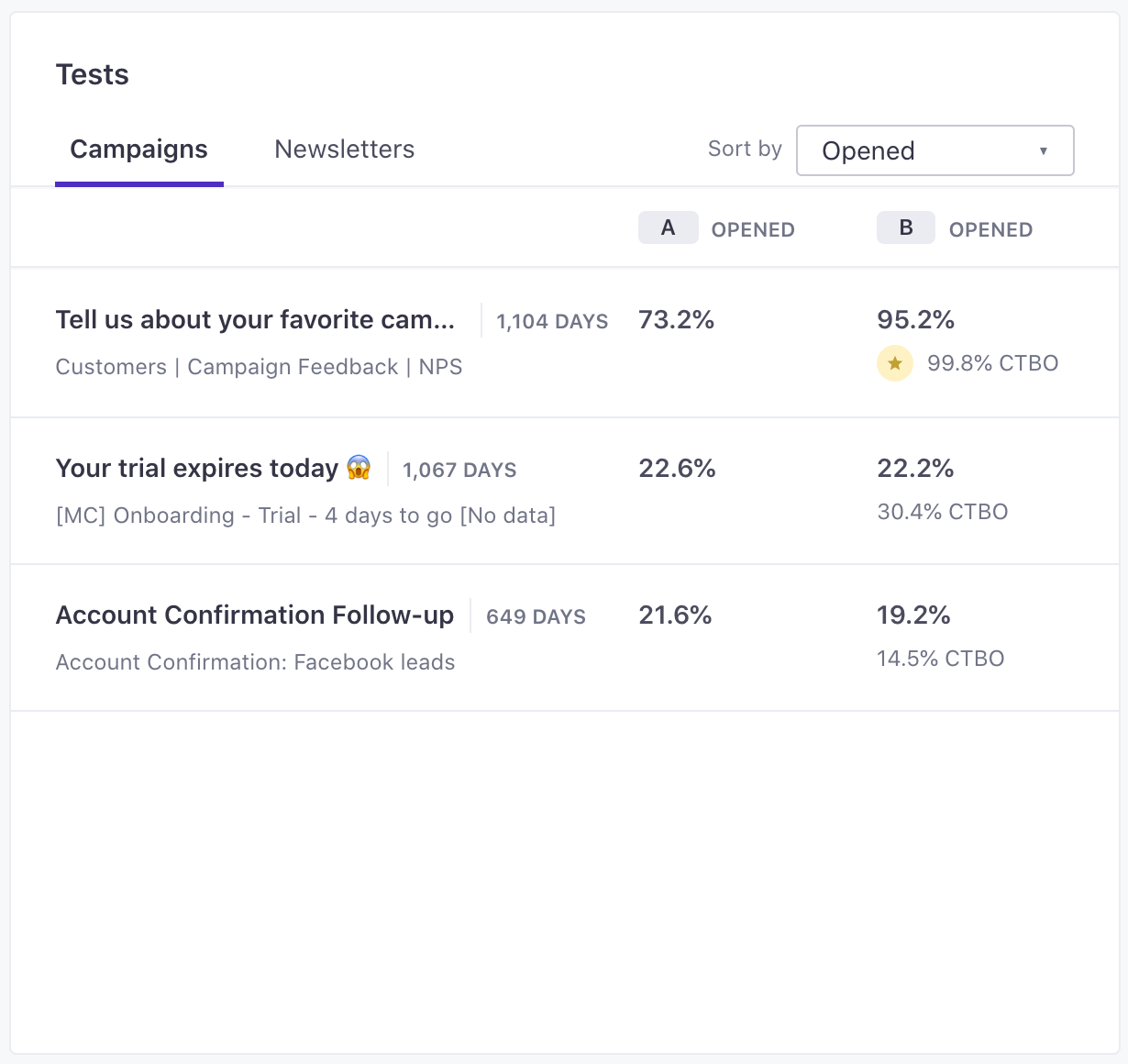

Newsletter Metrics
After sending a newsletter, view its metrics in the Overview tab. While campaigns and API-triggered broadcasts report journeyTypically, a person’s path through your campaign. If the campaign is triggered by a webhook, then a journey captures the webhook’s path, not a person’s. metrics, newsletters are single-send broadcasts and only produce message delivery metrics.
Click Analyze to open the Assistant and ask questions about the metrics. For instance, you could ask “What’s the click-to-open rate for this newsletter?” or “Of my product update newsletters, which had the lowest deliverability this month?”

